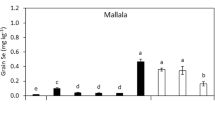Abstract
WITH the discovery of the importance and even the necessity of trace amounts of selenium in animal nutrition1, and with the recognition that the response of animals to the administration of selenium can vary2–5, it has become important to know more about the state of selenium in the soil and its uptake by plants. The first investigators were chiefly concerned with the uptake of selenium from seleniferous soil, with the accumulation of selenium by plants, and with the toxicity of these plants to domestic animals6. It has been suggested that there is a selenium cycle in nature7, but there is no evidence to substantiate some parts of this cycle, particularly where grassland is concerned.
This is a preview of subscription content, access via your institution
Access options
Subscribe to this journal
Receive 51 print issues and online access
$199.00 per year
only $3.90 per issue
Buy this article
- Purchase on Springer Link
- Instant access to full article PDF
Prices may be subject to local taxes which are calculated during checkout
Similar content being viewed by others
References
Schwarz, K., Nutrit. Rev., 18, 193 (1960).
Robertson, T. G., and During, C., N.Z. J. Agric., 103, 306 (1961).
Gardiner, M. R., Armstrong, J., Fels, H., and Glencross, R. N., Austral. J. Exp. Agric. Anim. Hus., 2, 261 (1962).
Sharman, G. A. M., Blaxter, K. L., and Wilson, R. S., Vet. Rec., 71, 536 (1959).
Muth, O. H., J. Amer. Vet. Med. Assoc., 142, 272 (1963).
Trelease, S. F., and Beath, O. A., Selenium (publ. by authors, New York, 1949).
Shrift, A., Nature, 201, 1304 (1964).
Peterson, P. J., and Butler, G. W., Austral. J. Biol. Sci., 15, 126 (1962).
Butler, G. W., and Peterson, P. J., N.Z. J. Agric. Res., 4, 484 (1961).
Peterson, P. J., and Spedding, D. J., N.Z. J. Agric. Res., 6, 13 (1963).
Cousins, F. B., and Cairney, I. M., Austral. J. Agric. Res., 12, 927 (1961).
Kulwich, R., Struglia, L., and Pearson, P. B., J. Nutrit., 61, 113 (1957).
Rosenfeld, I., and Eppson, H. F., Wyo. Agric. Exp. Sta. Bull., 414, 53 (1964).
Green, T. E., and Turley, M., Treatise on Analytical Chemistry, edit. by Kolthoff, I. M., Elving, P. J., and Sandell, E. B., 7, 137 (Interscience Publishers, New York, 1961).
Wolfe, E., Kollonitsch, V., and Kline, C. H., J. Agric. Food Chem., 11, 355 (1963).
Lakin, H. W., U.S. Dept. Agric. Handbook, 200, 3 (1961).
Watkinson, J. H., Trans. Joint Meeting Comm. IV and V Intern. Soc. Soil Sci., 149 (1962).
Author information
Authors and Affiliations
Rights and permissions
About this article
Cite this article
PETERSON, P., BUTLER, G. Colloidal Selenium Availability to Three Pasture Species in Pot Culture. Nature 212, 961–962 (1966). https://doi.org/10.1038/212961b0
Issue Date:
DOI: https://doi.org/10.1038/212961b0
This article is cited by
-
Critical Levels of Selenium in Different Crops Grown in an Alkaline Silty Loam Soil Treated with Selenite-Se
Plant and Soil (2005)
-
The uptake of applied selenium by agricultural plants
Plant and Soil (1970)
Comments
By submitting a comment you agree to abide by our Terms and Community Guidelines. If you find something abusive or that does not comply with our terms or guidelines please flag it as inappropriate.



